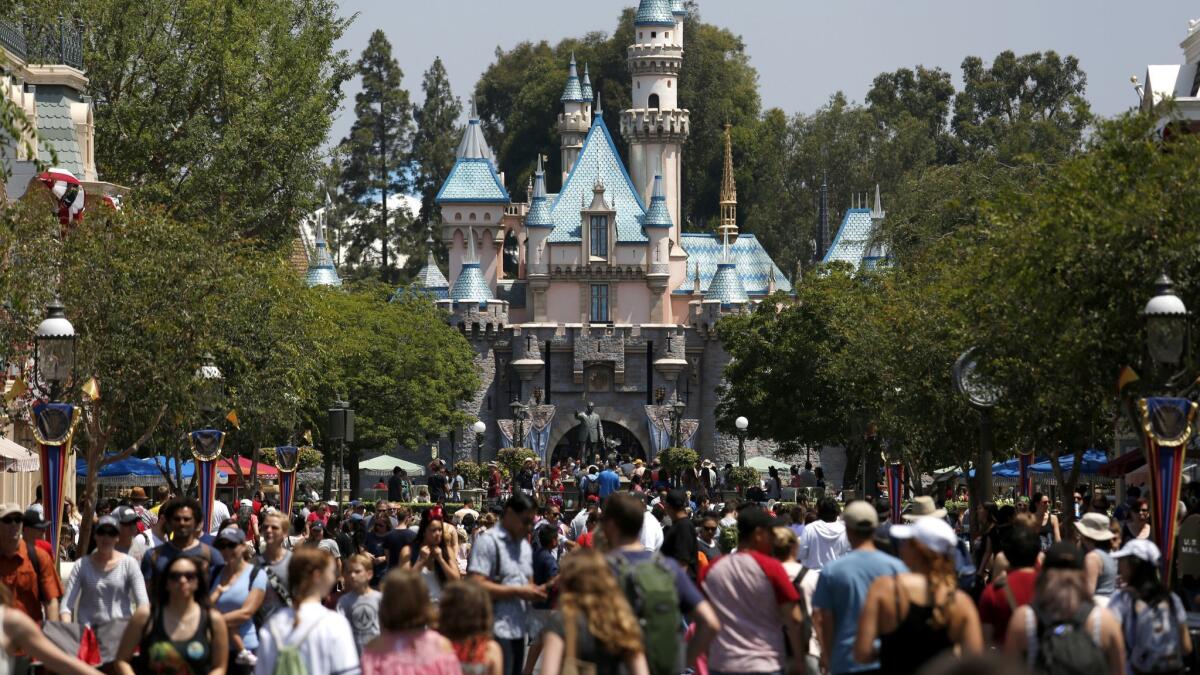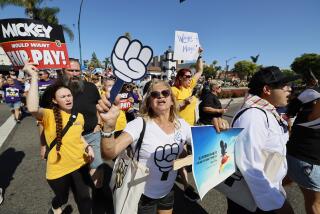State says Disney failed to properly clean cooling towers linked to Legionnaires’ outbreak; Disney disputes claims

- Share via
In what became one of the nation’s biggest Legionnaires’ disease outbreaks, 22 people fell sick with the dangerous lung infection last fall in Orange County, including one who died.
Local health officials said the outbreak seemed connected to Disneyland, as 19 of the 22 people who were infected had visited the park. But they never pinpointed a cause of the infections.
The California Occupational Safety and Health Administration in March cited the park and fined it more than $33,000 for failing to properly clean cooling equipment linked to the outbreak and for other related violations. Cal-OSHA didn’t announce the fine. The Times requested and recently obtained the citation.
Cal-OSHA looked into the Legionnaires’ cases because three Disneyland employees were sickened in the outbreak, two of them requiring hospitalization. The agency investigates only hazards that endanger workers, so its findings do not address how 19 non-employees were infected.
“The employer did not follow the manufacturer’s cooling tower start-up maintenance and water treatment procedure to control outbreaks of Legionnaires’ disease,” Cal-OSHA said in the citation. “As a result, two employees suffered serious illness requiring hospitalization of more than 24 hours.”
Disneyland officials said the source of the outbreak could have been elsewhere in Anaheim and have appealed the citation. They will make their case at a hearing before a three-member appeals panel in October.
“We strongly object to Cal OSHA’s allegation that our cooling towers caused any illness, since the source of the outbreak has never been scientifically determined,” Disneyland spokeswoman Suzi Brown said in a statement.
In August 2017, people who had visited Disneyland or spent time in Anaheim began to report feeling ill. They were diagnosed with Legionnaires’ disease, a lung infection caused by breathing in water droplets containing bacteria known as Legionella.
Disneyland’s cooling towers have been free of Legionella since November, and there is currently no risk to the public, Orange County health officials said.
The Times first reported on the outbreak in November. At the time, Disney said it had learned about “increased Legionnaires’ disease cases in Anaheim” from county health officials on Oct. 27.
“We conducted a review and learned that two cooling towers had elevated levels of Legionella bacteria,” Dr. Pamela Hymel, chief medical officer for Walt Disney Parks and Resorts, said in a statement at the time. “These towers were treated with chemicals that destroy the bacteria and are currently shut down.”
Approximately 6,000 people are diagnosed with Legionnaires’ disease nationwide each year, and about 1 in 10 die from it, according to the U.S. Centers for Disease Control and Prevention. The illness does not spread from person to person, so people who become sick each have to inhale the contaminated droplets.
Most Legionnaires’ outbreaks are linked to cooling towers, part of an air conditioning system that releases mist. Without proper cleaning, cooling towers can create the perfect environment for Legionella to grow. They require regular disinfecting to ensure they are not developing Legionella, experts say.
Tests last year showed high levels of the bacteria in two of Disneyland’s cooling towers around the time of the outbreak, so Orange County health officials ordered them shut down and disinfected.
But health officials never formally identified the cooling towers as the source, and Disneyland officials have said that the test results don’t definitively prove that the towers were to blame.
Brown said there are several cooling towers nearby that are outside the park and were never tested. She pointed out that three people who fell sick had not visited the park, including the one person who died.
The Cal-OSHA investigation found that Disneyland had not adequately cleaned the towers, which caused high levels of bacteria to grow.
One of the towers had been drained of water when it was taken offline at the beginning of 2017, but bacteria thrived in stagnant water still in the pipes, Cal-OSHA investigators said in a written report.
According to a Cal-OSHA document, Disneyland was “not effectively performing weekly bacteria inspections” at that time, so water containing Legionella was sent back into both cooling towers when they were brought online in August 2017.
“The employer failed to ensure equipment in service [was] kept clean, in sanitary condition, inspected and maintained as recommended by the manufacturer, as not to give rise to employee harmful exposure to Legionella pneumophila and other airborne bacteria,” the Cal-OSHA citation said.
The three workers who contracted Legionnaires’ disease — a cook, an operating engineer and a laborer — came within 50 to 200 feet of the cooling towers, a Cal-OSHA document said.
Disneyland typically tests its cooling towers quarterly, according to theme park records that were obtained through a public records request from the Orange County public health department.
But the cooling towers weren’t tested for Legionella last year while they were offline, the document shows. The first tests in 2017 came in late September, when the lab reports showed high levels of the bacteria.
Oladele Ogunseitan, chair of UC Irvine’s Department of Public Health, said stagnant water, such as what remained in the cooling tower pipes last year, is especially good at cultivating bacteria.
“That’s the culprit right there,” he said.
The bulk of the fines levied against Disneyland were for not cleaning the towers properly. The agency also fined Disneyland for not reporting all of the employee illnesses to Cal-OSHA.
“We have continually cooperated with Cal-OSHA’s various investigations, and fully complied with its reporting requirements with respect to our employees,” Brown said in the statement.
Ogunseitan said it seems unlikely there was a second source of Legionella outside Disneyland that contributed to the outbreak. If there had been, officials would have noticed another cluster of cases, he said. That the three cases happened around the same time suggests the infected people probably traveled close to the park.
“That makes the most sense — they must have breathed in the droplets from the cooling towers,” he said. “You can’t say there are other sources when they all happened at the same time.”
Twitter: @skarlamangla
More to Read
Sign up for Essential California
The most important California stories and recommendations in your inbox every morning.
You may occasionally receive promotional content from the Los Angeles Times.










